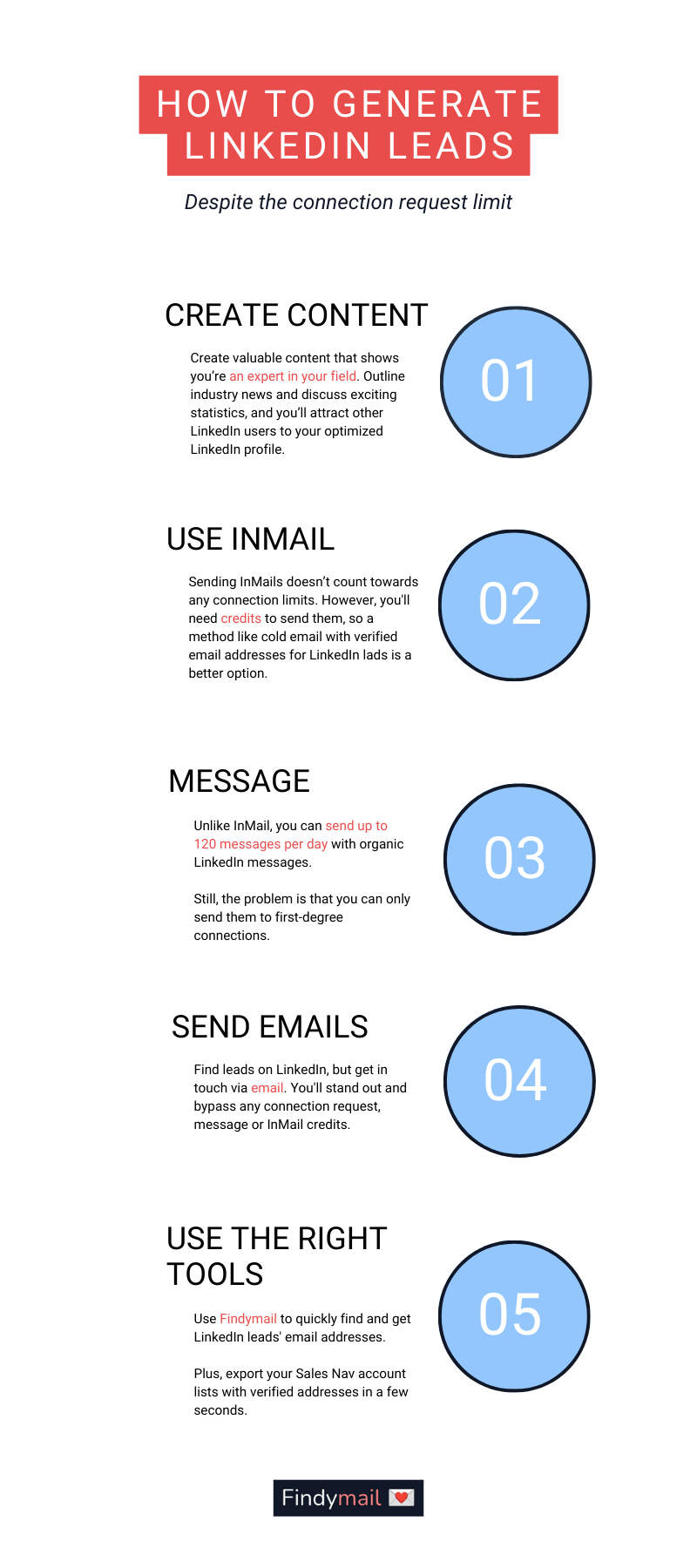A few years ago, you could send almost as many LinkedIn connection requests as you wanted. Well, being limited to about 800 per week didn't mean unlimited, but it was a lot. Basically, it was a free-for-all, and lead generation was a lot easier.
However, in 2021, LinkedIn changed its policy to improve user experience. Since 2021, you were now limited to fewer connection requests, impacting the number of leads you could generate from the platform.
Fortunately, all is not lost. There are some ways to generate leads despite the LinkedIn connection request limit!

What Is the LinkedIn Connection Request Limit?
On paper, LinkedIn wanted to make sure that members only receive relevant requests.
For this reason, the platform implemented a connection request limit that limits the number of connection requests you can send within a given period.
This limit also applies if many of your requests are left pending, unanswered, or marked as spam.
How Many Connection Requests Can You Send on LinkedIn?
Currently, LinkedIn users get about 100 connection requests per week. These days, some experts speculate that the number is closer to 200, but it’s still a considerable decrease from previous figures.
How Can You Get Past LinkedIn’s Connection Request Limit?
Fortunately, there are a few ways you can get past this connection request limit and keep your LinkedIn lead generation efforts on track.
Create Content to Get More Inbound LinkedIn Connection Requests
Creating more content is one of the best ways to reach and connect with more people on LinkedIn when you’ve exceeded your connection request limit.
But wait, how do you connect with people by creating content?
When you create valuable content that shows you’re an expert in your field, outlines industry news, and discusses exciting statistics, you’ll attract other LinkedIn users to your optimized LinkedIn profile. In turn, this results in more connection requests from other users.
In other words, your content allows you to connect with people without using any connection requests yourself. And remember, while you create content once, it keeps on delivering value as long as it’s on your profile.
Use LinkedIn InMail
Another alternative to get past the connection request limit is to use LinkedIn’s InMail feature. Sending these InMails doesn’t count towards any connection limits.
It goes further than this, though, and InMail also offers some other benefits. For instance, it provides a higher response rate than regular emails or messages on LinkedIn.
It's not all good news, though, and there are some significant drawbacks to using InMail.
For instance, it is a paid feature; you only get a certain allotment of messages during every billing cycle. If you need more InMail credits, you’ll need to pay for them.
Your credits depend on your LinkedIn account type, too. When you subscribe to the Premium Career plan, you’ll only get 5 InMail credits every month. Likewise, when you subscribe to Sales Navigator, you’ll get 50 credits during each monthly billing cycle.
You won’t be able to send another InMail message to a LinkedIn member until they’ve responded to your first message. While you’ll get your credit back if they don’t respond within 90 days, it’s a credit that you can’t use. As a result, this limits your lead generation capacity.
Ultimately, InMail can effectively get past the connection request limit on LinkedIn, but considering the above limitations, it should be your last resort.
Use LinkedIn Messages
Unlike InMail, you can send up to 120 messages per day with organic LinkedIn messages. Still, the problem is that you can only send them to first-degree connections.
In that sense, InMail is better for outreach than Messages, but if you’ve connected with plenty of leads, you can use Messages to stay in touch with them.
Find Leads on LinkedIn, but Send Emails
Fortunately, email solves many of the problems and drawbacks of LinkedIn connections and InMail:
- Most businesses already have email, so you won’t have to pay to get in touch with your leads.
- With a warmed-up inbox, you can send significantly more than 100 emails weekly.
- You can follow up with leads (even if they haven’t responded to your first email).
Finally, when using email for marketing or sales messages, you will typically use an email platform that provides deeper insights into your email data. This means you can see what parts of your campaign do well, what parts need work, and where you can improve. While you get some analytics capabilities with InMail, you won’t get these in-depth insights.
Despite the above advantages, email does have a significant disadvantage. Simply put, to send someone an email, you’ll first need their email address. Your email client can’t provide that, but Findymail can. ;)
Use the Right Tools
FindyMail allows you to find emails on LinkedIn quickly and easily. You can even export Sales Navigator email addresses in bulk!
Not only will you get the email addresses of your LinkedIn leads, but Findymail will automatically clean the data and verify the email addresses. Send away, knowing that the addresses are correct and your sender reputation won’t be harmed.
So, ultimately, LinkedIn is fantastic for sourcing leads but turn to email and Findymail to bypass LinkedIn’s connection request limit. To learn more about the platform and how it can help your lead generation efforts, get started for free today!


